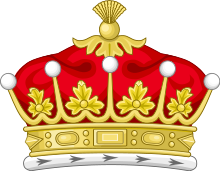Earl
![]()
The title of this article is ambiguous. For other meanings, see Earl (disambiguation).
Earl (br. [ɜ:ɫ], am. [ɜrɫ]) is a British title of nobility, equivalent to the German count. Earls outside the British Isles are referred to in English as "count". The feminine form of Earl - as well as Count - is "Countess".
The term Earl originated from the Danish Jarl and was adopted since the conquest of England by the Anglo-Scandinavian King Knut in 1016 instead of the Saxon Ealdorman which had been in use until then. It denoted the highest level of English nobility until around the middle of the 14th century. In Scotland, the title Mormaer developed into the vernacular equivalent of earl.
After the Norman conquest of England under William the Conqueror in 1066, earls effectively had only the rank of earls. When Edward III appointed his son Edward of Woodstock, the so-called "Black Prince", Duke of Cornwall in 1337, the Earl title fell to second and, when in 1385 Richard II. Robert de Vere to Marquess of Dublin, it descended to the third level.
Nowadays, the title Earl is a pure distinction of rank without any relation to territorial power. Like the Viscount and the Baron, the Earl is to be addressed as "The Right Honourable" (styled) and "My Lord" (adressed).
The rank crown of an earl consists of a browband set with precious stones, on which there are sixteen golden prongs, alternately set with golden strawberry leaves and silver pearls. The eight pearl prongs are four times higher than the leaf prongs. A scarlet cap is surrounded by the prongs and the crown appears tall and plump. The golden browband is trimmed with ermine. The parliamentary mantle is scarlet and has a triple ermine trim. The heraldic rank crown of the Earls is limited to the stylized side view of the crown with four leaf and five pearl prongs visible and with tassel on the cap.

The Royal Procession to Parliament at Westminster, 4 February 1512; from left to right: an unknown Marquess, the Marquess of Dorset, Earl of Northumberland, Earl of Surrey, Earl of Shrewsbury, Earl of Essex, Earl of Kent, Earl of Derby and Earl of Wiltshire. From: Parliament Procession Roll of 1512

Earl of Devon's crown, which he wore at the coronation of Elizabeth II.

Heraldic rank crown of an earl
Search within the encyclopedia